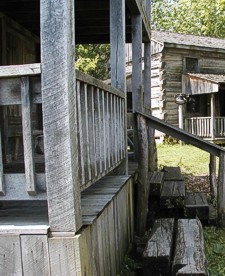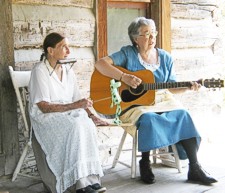| They didn't
always come with Hot Tubs Roughing it a bit and staying in a cabin this weekend? If you are
enjoying the experience, perhaps you'd like to see how it all got started in Hocking
County.

A village of original log cabins
Robbins Crossing is a collection of original log cabins
built by settlers of the Valley in the 1850s. These cabins were donated by landowners, and
carefully dismantled at their original locations. The cabins were then reassembled
at Robbins Crossing to form what might have been a typical village for the settlers.
You'll see a completely furnished one-room schoolhouse, a
general store, and several one-story and two-story dwellings, including a cooper shop, blacksmith
shop, and pottery station. An old barn and a vegetable garden provide an additional
glimpse of what life was like back when cabins where the only form of shelter in the
Valley. (Of course, there were tipis, but we'll talk about them some other time.)

A close-up look at history
All of these buildings are open for you to stroll
through. The interiors are no less authentic than the rustic exteriors, having been
completely furnished with artifacts from the period.

|
|

Although we don't encourage you to handle any of the
antiques or other items in the cabins, nothing is roped off. Nearly all areas are
available for your close-up (but careful) inspection. You'll see real tools, clothing, and
household goods once used by the settlers, and come away with a good sense of what family
life was like back in those days.

And, you'll find plenty of friendly "residents"
dressed in period garb, who are working or just strolling about.
Students and local volunteers
demonstrate cooking, chip carving, lace making, and blacksmithing as those activities were
done in the 19th century. When we were there, we also enjoyed hearing musicians, and
watching young children rolling hoops and enjoying other pastimes of the era.

A visit to Robbins Crossing is one of the best ways we can
think of to get an authentic, living glimpse of this period of Southeastern Ohio history.
|
|
Other
things to do at Robbins Crossing
One of the cabins at the Crossing features dolls and other
crafts for sale by local artisans. The general store offers lots of interesting
items, including penny candy and other homemade goodies. Books about the region, CDs and
tapes by local artists, some antiques, and crafts are also available for you to browse and
purchase if you want. Shaded areas and a gazebo on the grounds invite you to picnic.
More ways than one to get there
You can reach Robbins Crossing easily by car, but for an
even more back-to-the past experience, why not take the train? The Hocking Valley
Scenic Railroad offers short trips on a steam train between their station in
Nelsonville and the Crossing. Once again, you'll enjoy conductors and ticket takers in
period garb, not to mention a wonderful steam whistle. As a bonus, those who operate the
train are knowledgeable railroad enthusiasts, who can add their own share of history
to your visit.

Robbins Crossing is located on the campus of
Hocking College, on the southeastern side of Nelsonville. The village is open every
weekend from Memorial Day through the end of October. For more information, call
740-753-3591, extension 2555, or visit their Web site at www.robbinscrossing.org. For more
information on taking the Hocking Valley Scenic Railroad to Robbins Crossing, call
1-800-967-7834, or visit their Web site at www.hvsr.com.
 |